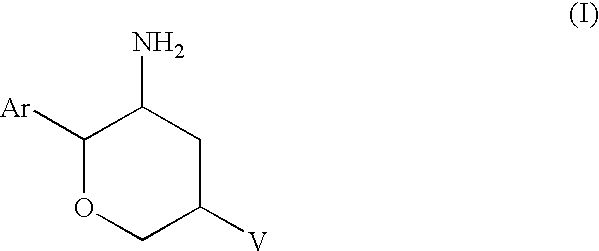Aminotetrahydropyrans as dipeptidyl peptidase-IV inhibitors for the treatment or prevention of diabetes
a technology of dipeptidase and aminotetrahydropyrans, which is applied in the direction of biocide, drug composition, metabolic disorder, etc., can solve the problems of increased and premature morbidity and mortality, increased risk of macrovascular and microvascular complications in patients with type 2 diabetes mellitus, and increased plasma insulin levels
- Summary
- Abstract
- Description
- Claims
- Application Information
AI Technical Summary
Problems solved by technology
Method used
Image
Examples
example 1
[0214]
(2R,3S,5R)-5-(1-Methyl-4,6-dihydropyrrolo[3,4-c]pyrazol-5(1H)-yl)-2-(2,4,5-2H-pyran-3-amine, dihydrochloride salt
Step A: tert-Butyl [(2R,3S,5R)-5-(1-methyl-4,6-dihydropyrrolo[3,4-c]pyrazol-5(1H)-2-(2,4,5-trifluorophenyl)tetrahydro-2H-pyran-3-yl carbamate
[0215]To a stirred solution of Intermediate 1 (50 mg, 0.145 mmol) and Intermediate 4 (29 mg, 0.235 mmol) in methanol (1.0 mL) was added decaborane (6 mg, 0.048 mmol), and the mixture was stirred for 15 h and evaporated under reduced pressure. The product (TLC less-mobile diastereoisomer) was purified by preparative thin layer chromatography with 5% methanol in dichloromethane to give tert-butyl [(2R,3S,5S)-5-(1-methyl-4,6-dihydropyrrolo[3,4-c]pyrazol-5(1H)-yl)-2-(2,4,5-trifluorophenyl)tetrahydro-2H-pyran-3-yl carbamate. LC-MS 453.17 (M+1).
Step B: (2R,3S,5R)-5-(1-Methyl-4,6-dihydropyrrolo[3,4-c]pyrazol-5(1H)-yl)-2-(2,4,5-trifluorophenyl)tetrahydro-2H-pyran-3-amine dihydrochloride salt
[0216]tert-Butyl [(2R,3S,5S)-5-(1-methyl-4,6-...
example 2
[0217]
(2R,3S,5R)-5-(1-Methyl-4,6-dihydropyrrolo[3,4-c]pyrazol-5(1H)-yl)-2-(2,4,5-trifluorophenyl)tetrahydro-2H-pyran-3-amine dihydrochloride salt
[0218]This compound was prepared in a similar manner as Example 1, Step B, but using tert-butyl [(2R,3S,5R)-5-(1-methyl-4,6-dihydropyrrolo[3,4-c]pyrazol-5(1H)-yl)-2-2,4,5-trifluorophenyl)tetrahydro-2H-pyran-3-yl carbamate obtained as the TLC more-mobile diastereoisomer from Step A of Example 1. 1H NMR (500 MHz, CD3OD): δ 8.14-8.05 (m, 1H); 7.41(s, 1H); 7.31-7.24(m, 1H); 4.96-4.82(m, 4H); 4.52(d, 1H, J=16 Hz); 4.20(s, 1H); 4.14-4.04(m, 2H); 3.90(s, 3H); 3.33-3.28 (m, 1H); 2.83(d, 1H, J=16 Hz); 2.41(t, 1H, J=16 Hz); LC-MS 353.17 (M+1).
example 3
[0219]
(2R,3S,5R)-2-(2,5-Difluorophenyl)tetrahydro)-5-(4,6-dihydropyrrolo[3,4-c]pyrazol-5(1H)-yl) tetrahydro-2H-pyran-3-amine, dihydrochloride salt
Step A: tert-Butyl [(2R,3S,5R)-2-(2.5-difluorophenyl)-5-(4,6-dihydropyrrolo[3,4-c]pyrazol-5(1H)-yl)-)tetrahydro-2H-pyran-3-yl carbamate
[0220]A solution of Intermediate 2 (6.03 g, 18.4 mmol) and Intermediate 3 (2.61 g, 23.94 mmol) in methanol (135 mL) was stirred for 30 min and then treated with decaborane (674 mg, 5.53 mmol). The mixture was stirred overnight and evaporated under reduced pressure. The residue was purified on Horizon® (silica, successive elution with ethyl acetate (6 L), 5-6% ethanol containing 10% ammonium hydroxide in ethyl acetate (2 L), 8-12% ethanol containing 10% ammonium hydroxide in ethyl acetate (3 L) to yield the title compound as the less-mobile diastereoisomer (silica, TLC 6% methanol containing 10% ammonia in dichloromethane). 1H NMR (500 MHz, CD3OD): δ 1.18-1.24 (m, 9H), 1.59-1.65 (q, 1H), 2.4 (m, 1H), 3.06 (m...
PUM
| Property | Measurement | Unit |
|---|---|---|
| volume | aaaaa | aaaaa |
| emission wavelength | aaaaa | aaaaa |
| excitation wavelength | aaaaa | aaaaa |
Abstract
Description
Claims
Application Information
 Login to View More
Login to View More - R&D
- Intellectual Property
- Life Sciences
- Materials
- Tech Scout
- Unparalleled Data Quality
- Higher Quality Content
- 60% Fewer Hallucinations
Browse by: Latest US Patents, China's latest patents, Technical Efficacy Thesaurus, Application Domain, Technology Topic, Popular Technical Reports.
© 2025 PatSnap. All rights reserved.Legal|Privacy policy|Modern Slavery Act Transparency Statement|Sitemap|About US| Contact US: help@patsnap.com



